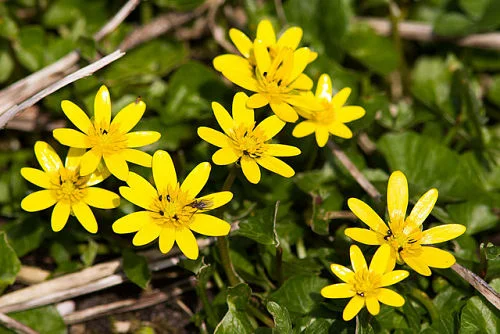When "pretty" is not enough
/The lesser celandine, a deceptively pretty little thug. — Natural England/Flickr
"Rear who will a pyramid
Praise it is enough,
If there be but three or four
Who will love my little Flower."
— William Wordsworth
The poet William Wordsworth was so enchanted with the little spring bloomer known as the lesser celandine that he wrote no fewer than three poems singing its praises.
He believed its starry, butter-yellow flowers gave painters the idea for picturing the rising sun ringed by a crown of rays. He even had the “little celandine” carved on his tombstone.
Back in 1803 and 1804 when he was waxing rhapsodic about it, Wordsworth lived in native territory of the lesser celandine. In England it grows in hedgerows and damp meadows, where it is one of the first wildflowers to bloom. It’s welcomed throughout the British Isles, where the poet is not the lesser celandine’s only fan.
Travel with me now some two hundred years and 3,000 miles west to coastal New Jersey, where my own clump of lesser celandine had been growing unmolested for several years. Barely six inches tall, the solid mass of heart-shaped leaves is studded in early spring with pretty little yellow buttercups, as glossy as enamel. “Spring messenger“ is another of its common names. “Moral dilemma” is what I call it.
Although this seemingly innocuous little flower won a British poet’s heart, here — and in 19 other states — it is an unwelcome guest, an invasive non-native species.
I got mine from Mrs. King, the lilac queen, who dug me a shovel-full when I admired the way it carpeted the ground under her many lilacs. I plunked it in my entry garden, and thought at first that it had not survived transplanting since it shortly withered away.
But no, the lesser celandine is a spring “ephemeral” that rises in March, blooms in April and is gone before May is done, retreating underground for another year. Ficaria verna, formerly known as Ranunculus ficaria, is quite unrelated to the greater celandine, a plant in the poppy family that blooms through much of the summer.
A solid blanket of celandine, smothering all in its path. — David Nutter/Flickr
I hadn’t thought much more about it until I saw the lesser celandine on the equivalent of a “Wanted” poster. It was on a list of plants notorious for aggressively grabbing territory and crowding native wildflowers out of their ancestral homes. Since I’m trying to raise my consciousness (along with yours) about the threat of invasive exotic plants, I had another look at the plant in question this spring.
The tiny transplant had by now grown into a dense, unbroken mass measuring perhaps 18 inches by 24. When I looked closer, I was alarmed to see that single celandines had left the mother colony and were claiming spots here and there throughout the bed.
Like most troublesome plants, the lesser celandine has competitive advantages over native species. For one thing, it emerges sooner than many of our own spring ephemerals, including marsh marigold, trout lilies, Virginia bluebell and hepatica. For another, it spreads not only via underground tubers, but by bulblets that form along the stems as the flowers begin to fade.
These can be carried everywhere by digging animals, by inattentive weeders and by flood. The lesser celandine is especially fond of damp woodlands and streamsides, earning itself the name “Marsh Menace.” In wet ground, the celandine’s spread is inexorable and smothering — no native wildflowers can penetrate its thick green blanket.
I looked around, weighing the consequences. On the banks of my stream, I could see colonies of native trout lilies beginning to flower; in the wetland hollows, skunk cabbage was unfurling its lettuce-green leaves. A little shiver ran up my spine as I thought of how much harm I might have done had I tucked my gift plant in the woodlands rather than upland, next to the house in drier soil.
Good stewardship sometimes requires hard choices, which is a point often hard to make to those heavily invested in a single species (the deer and feral cat people, for instance). It also cuts no ice to say that invasive plants are “pretty” when they are reshaping our landscapes and eliminating the species that evolved here.
In the end, it is the complex, living habitat that has my strongest loyalty, the ideal of nature-in-balance. No one thing can mean as much as the healthy whole, and my cute but aggressive spreader would surely at some point escape into the wild. With a sigh, I picked up my shovel and started digging. I wished the lesser celandine a long and happy life in its native land as I bagged it for disposal in mine.


